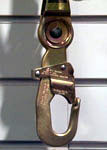Construction eTool
Falls » Personal Fall Arrest Systems
A personal fall arrest system is one option of protection that OSHA requires for workers on construction sites who are exposed to vertical drops of 6 feet or more.
Additional Information:
- 29 CFR 1926 Subpart M, Fall protection. OSHA Standard.
- 1926.502, Fall protection systems criteria and practices
- 1926.502(d), Personal fall arrest systems
- 1926.502, Fall protection systems criteria and practices
- Interpretations and Clarifications - Subpart M -- Fall Protection [29 CFR 1926.500-503].OSHA, (February 1995).
- Worker Deaths by Falls: A Summary of Surveillance Findings and Investigative Case Reports. US Department of Health and Human Services (DHHS), National Institute for Occupational Safety and Health (NIOSH) Publication 2000-116, (September 2000).

The attachment of the body harness must be located in the center of the wearer's back, near the shoulder level, or above the head.
Additional Information:
- 29 CFR 1926.502, Fall protection systems criteria and practices
Body harnesses are designed to minimize stress forces on an employee's body in the event of a fall, while providing sufficient freedom of movement to allow work to be performed.
- Do not use body harnesses to hoist materials.
- As of January 1, 1998, body belts are not acceptable as part of a personal fall arrest system, because they impose a danger of internal injuries when stopping a fall.


Additional Information:
- 29 CFR 1926 Subpart M, Fall protection. OSHA Standard.
- 1926.502, Fall protection systems criteria and practices


Vertical lifelines or lanyards must have a minimum breaking strength of 5,000 pounds, and be protected against being cut or abraded. Each employee must be attached to a separate vertical lifeline, except during the construction of elevator shafts, where two employees may be attached to the same lifeline in the hoistway, provided:
- Both employees are working atop a false car that is equipped with guardrails.
- The strength of the lifeline is 10,000 pounds (5,000 pounds per employee).
- All other lifeline criteria have been met.
Self-retracting vertical lifelines and lanyards that automatically limit free fall distance to 2 feet or less must be capable of sustaining a minimum tensile load of 3,000 pounds when in the fully extended position. If they do not automatically limit the free fall to 2 feet or less, ripstitch lanyards, and tearing and deforming lanyards, must be capable of sustaining a minimum tensile load of 5,000 pounds when in the fully extended position.
Additional Information:
- 29 CFR 1926 Subpart M, Fall protection. OSHA Standard.
- 1926.502, Fall protection systems criteria and practices

Webbing are the ropes and straps used in lifelines, lanyards, and strength components of body harnesses. The webbing must be made from synthetic fibers.
Additional Information:
- 29 CFR 1926 Subpart M, Fall protection. OSHA Standard.
- 1926.502, Fall protection systems criteria and practices
Anchorages used for attachment of personal fall arrest equipment must be independent of any anchorage being used to support or suspend platforms, and capable of supporting at least 5,000 pounds per employee attached, or must be designed and used as follows:

- As part of a complete personal fall arrest system which maintains a safety factor of at least two.
- Under the supervision of a qualified person.
Additional Information
- 29 CFR 1926 Subpart M, Fall protection. OSHA Standard.
- 1926.502, Fall protection systems criteria and practices

Horizontal lifelines are to be designed, installed, and used under the supervision of a qualified person, and as part of a complete personal fall arrest system which maintains a safety factor of at least two.
On suspended scaffolds or similar working platforms with horizontal lifelines that may become vertical lifelines, the devices used to connect to a horizontal lifeline must be capable of locking in both directions on the lifeline.
Additional Information
- 29 CFR 1926 Subpart L, Scaffolds. OSHA Standard.
- 1926.451, General requirements
- 29 CFR 1926 Subpart M, Fall protection. OSHA Standard.
- 1926.502, Fall protection systems criteria and practices

Connectors:
Connectors, including D-rings and snaphooks, must be made from drop-forged, pressed or formed steel, or equivalent materials. They must have a corrosion-resistant finish, with smooth surfaces and edges to prevent damage to connecting parts of the system.

D-Rings:
D-Rings must have a minimum tensile strength of 5,000 pounds, and be proof-tested to a minimum tensile load of 3,600 pounds without cracking, breaking, or becoming permanently deformed.

Snaphooks:
Snaphooks must have a minimum tensile strength of 5,000 pounds, and be proof-tested to a minimum tensile load of 3,600 pounds without cracking, breaking, or becoming permanently deformed. They must also be locking-type, double-locking, designed and used to prevent the disengagement of the snaphook by the contact of the snaphook keeper with the connected member. Unless it is designed for the following connections, snaphooks must not be engaged:
- Directly to webbing, rope, or wire.
- To each other.
- To a D-ring to which another snaphook or other connector is attached.
- To a horizontal lifeline.
- To any object which is incompatibly shaped in relation to the snaphook such that the connected object could depress the snaphook keeper and release itself.
Additional Information:
- 29 CFR 1926 Subpart M, Fall protection. OSHA Standard.
- 1926.502, Fall protection systems criteria and practices

- Ensure that personal fall arrest systems will, when stopping a fall:
- Limit maximum arresting force to 1,800 pounds.
- Be rigged such that an employee can neither free fall more than 6 feet nor contact any lower level.
- Bring an employee to a complete stop and limit maximum deceleration distance to 3½ feet.
- Have sufficient strength to withstand twice the potential impact energy of a worker free falling a distance of 6 feet, or the free fall distance permitted by the system, whichever is less
- Remove systems and components from service immediately if they have been subjected to fall impact, until inspected by a competent person and deemed undamaged and suitable for use.
- Promptly rescue employees in the event of a fall, or assure that they are able to rescue themselves.
- Inspect systems before each use for wear, damage, and other deterioration, and remove defective components from service.
- Do not attach fall arrest systems to guardrail systems or hoists.
- Rig fall arrest systems to allow movement of the worker only as far as the edge of the walking/working surface, when used at hoist areas.









